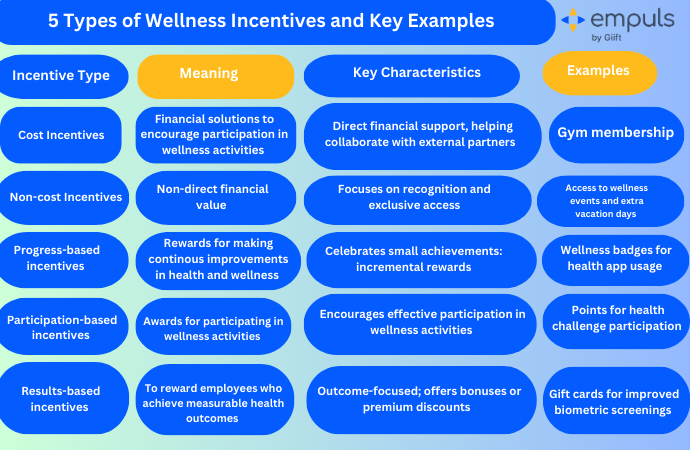Comment les incitations au bien-être favorisent-elles l'engagement des employés ?
Les incitations au bien-être sont un programme de soins de santé puissant conçu pour améliorer le bien-être des employés. Découvrez les différents types d'incitations et les façons dont elles stimulent l'engagement.
Sur cette page
- Qu'est-ce qu'une incitation au bien-être ?
- Qu'est-ce qu'un programme d'incitation au bien-être ?
- Comment les incitations au bien-être favorisent-elles l'engagement des salariés ?
- Types d'incitations au bien-être
- Conseils pour choisir les bonnes mesures d'incitation au bien-être pour les salariés
- Études de cas
- Comment Empuls crée-t-elle un programme d'incitation au bien-être solide ?
- Conclusion
Une enquête Gallup menée auprès de 160 000 employés a révélé que les personnes qui sont productives au travail subissent également beaucoup de stress. En guise d'aide, les organisations qui introduisent et mettent en œuvre des programmes de bien-être peuvent contribuer à accroître la satisfaction des employés. À l'appui de cette affirmation, un rapport de Metlife sur les tendances en matière de bien-être au travail indique que 70 % des travailleurs sont plus satisfaits lorsque leur entreprise met en place des mesures d'incitation au bien-être pour les employés.
Les organisations qui garantissent une participation active aux programmes de bien-être créent un environnement de collaboration qui attire également une culture d'entreprise de qualité. Le comité de bien-être est un acteur clé de ce processus. Il peut vous aider à démarrer en introduisant des avantages liés à la santé et à la condition physique, tels que des abonnements à des salles de sport, des trackers de condition physique et des défis. Vous pouvez ensuite ajouter des programmes de mode de vie et de bien-être tels que des programmes de gestion du poids et de conseils nutritionnels.
Pour une meilleure analyse du bien-être des salariés et des mesures d'incitation, nous commencerons par examiner les bases des mesures d'incitation au bien-être, puis nous passerons aux types de mesures et aux conseils pour choisir les bonnes mesures d'incitation au bien-être pour les salariés.
Qu'est-ce qu'une incitation au bien-être ?
Imaginez un lieu de travail où les habitudes saines sont encouragées et récompensées. Telle est l'essence des incitations au bien-être, des programmes stratégiques conçus pour motiver les employés à adopter un mode de vie plus sain. Ces initiatives vont au-delà du bien-être physique et englobent également la santé mentale et émotionnelle.
En offrant des récompenses pour la participation à des activités de bien-être et la réalisation d'objectifs spécifiques, les entreprises investissent dans leur atout le plus précieux : leurs employés. Les incitations au bien-être reconnaissent la nature multidimensionnelle de la santé des employés et créent une culture qui donne la priorité au bien-être.
Les récompenses elles-mêmes peuvent être diverses, allant d'une réduction des primes de soins de santé à des contributions à des comptes d'épargne santé, en passant par des abonnements à des salles de sport ou même des primes en espèces. Le principe de base est de rendre la santé et le bien-être inséparables de l'ADN de l'entreprise.
Qu'est-ce qu'un programme d'incitation au bien-être ?
Un programme d'incitation au bien-être est une initiative sur le lieu de travail conçue pour motiver les employés à adopter des comportements sains et à améliorer leur bien-être général. Ces programmes combinent généralement des ressources éducatives et des systèmes de récompense pour encourager la participation.

Comment les incitations au bien-être favorisent-elles l'engagement des salariés ?
Les incitations au bien-être peuvent être un outil puissant pour stimuler l'engagement des employés de plusieurs façons :
1. Motivation par un coup de pouce initial
Parfois, nous avons tous besoin d'un petit coup de pouce pour démarrer, surtout lorsqu'il s'agit de prendre de nouvelles habitudes. Selon un communiqué de presse de l'APA, 9 travailleurs sur 10 se sentent plus motivés si leur entreprise soutient l'intégration de programmes de bien-être.
Les incitations constituent une première motivation pour participer à un programme de bien-être, essayer une nouvelle activité comme le yoga ou donner la priorité à une alimentation saine. Elles peuvent être particulièrement utiles pour vaincre l'inertie et aider les employés à franchir le premier obstacle.
2. Une plus grande participation, de meilleurs résultats
Des études montrent que l'offre d'incitations entraîne des taux de participation nettement plus élevés aux programmes de bien-être. Selon Healthcare Value Hub, 46% des grandes entreprises utilisent des incitations basées sur la participation et 5 % utilisent une approche basée sur les résultats.
Lorsque davantage d'employés sont impliqués, le programme lui-même prend de l'ampleur et peut créer une culture plus positive et plus soucieuse de la santé au sein de l'entreprise. Cet engagement accru peut renforcer le sens de la communauté et de la camaraderie parmi les employés.
3. Mettre l'accent sur divers aspects du bien-être
Ne vous concentrez pas uniquement sur la santé physique. Offrez des incitations qui favorisent le bien-être mental, le bien-être financier et les relations sociales. Cette approche globale répond à un plus grand nombre de besoins des employés et favorise une vision plus holistique du bien-être.
4. Rendre les choses amusantes et engageantes
Envisagez d'intégrer des défis d'équipe ou des activités sociales aux mesures d'incitation. Cela peut rendre la participation plus agréable et encourager un sentiment de compétition amicale.
5. Équilibrer les récompenses extrinsèques et intrinsèques
Si les incitations sont un bon début, l'objectif est que les employés comprennent eux-mêmes l'intérêt d'adopter des habitudes saines. Cela peut conduire à des changements positifs plus durables.
6. Aligner les incitations sur les préférences des salariés
Réalisez des enquêtes ou des groupes de discussion pour comprendre ce qui motive vos employés. Il peut s'agir de cartes-cadeaux, de jours de vacances supplémentaires ou de réductions sur les abonnements à un centre de remise en forme. En personnalisant les incitations, vous montrez que vous vous souciez de leurs besoins individuels et rendez les récompenses plus attrayantes.
7. Privilégier le progrès à la perfection
Fixez des objectifs réalisables et récompensez les employés pour les étapes franchies en cours de route, et pas seulement pour l'objectif final. Cela crée un sentiment d'accomplissement et maintient leur motivation tout au long du programme.
8. Offrir une variété de niveaux d'incitation
L'offre d'une gamme de récompenses peut répondre à différents niveaux de participation. De petites incitations peuvent récompenser la participation initiale, tandis que des récompenses plus importantes peuvent être liées à la réalisation d'objectifs à long terme. Ce système à plusieurs niveaux permet de répondre à différents niveaux d'engagement et de maintenir l'implication de chacun.
9. Le rendre visible et transparent
Communiquer clairement les détails du programme d'incitation, y compris la manière de gagner des récompenses et de suivre les progrès. Des mises à jour régulières et la reconnaissance de ceux qui ont franchi des étapes importantes peuvent inciter davantage à la participation.
10. Promouvoir une culture du bien-être
Ne donnez pas l'impression que les incitations au bien-être constituent un programme à part. Intégrez-les à la culture de l'entreprise en demandant à la direction de participer activement, en offrant des collations saines dans la salle de repos ou en organisant des réunions de marche. Cela renforce le message selon lequel le bien-être est une valeur fondamentale de l'organisation.

Types d'incitations au bien-être
1. Incitations financières
Les barrières financières peuvent souvent faire obstacle à l'adoption d'habitudes saines. Les incitations financières constituent une approche stratégique pour relever ce défi, en encourageant directement la participation des employés aux programmes de bien-être en allégeant le fardeau financier.
Ces incitations comprennent des subventions pour les abonnements à des salles de sport, des rabais sur les primes d'assurance maladie en fonction de la participation au programme, ou même des contributions directes aux comptes d'épargne santé (HSA) des employés.
Les incitations financières peuvent être divisées en trois catégories
- Incitations peu coûteuses : (moins de 100 $) - Bouteilles d'eau, sacs, tapis de yoga, écouteurs, etc.
- Incitations à coût moyen : (100 $ - 300 $) - Abonnements à des clubs de gym, chaussures, équipements de santé et dispositifs portables.
- Incitations coûteuses : (plus de 300 $) - vacances, téléphones mobiles, ordinateurs portables, etc.
2. Incitations non financières
Si les récompenses financières sont des facteurs de motivation précieux, les programmes de bien-être peuvent être encore améliorés par l'intégration d'incitations non financières. Ces mesures incitatives visent à offrir une reconnaissance et des avantages que les employés apprécient particulièrement, sans que l'entreprise n'ait à débourser directement de l'argent.
Voici un aperçu de la diversité des incitations non financières :
- Reconnaître publiquement les employés qui franchissent des étapes importantes en matière de bien-être en les mentionnant dans les bulletins d'information de l'entreprise, en les reconnaissant sur les médias sociaux ou en les récompensant dans le cadre de programmes spéciaux.
- Offrir des congés payés supplémentaires aux personnes qui relèvent des défis en matière de bien-être ou qui atteignent des objectifs spécifiques.
- Offrir un accès exclusif à des événements, des ateliers ou des séminaires sur le bien-être animés par des professionnels de la santé.
- Offrez des récompenses non monétaires souhaitables, telles que des places de parking prioritaires, des modalités de travail flexibles ou des réductions sur des options alimentaires saines.
3. Incitations basées sur les progrès
Les programmes de bien-être traditionnels se concentrent souvent uniquement sur les objectifs finaux. Les incitations basées sur les progrès adoptent une approche plus nuancée, reconnaissant et récompensant le cheminement continu vers un meilleur bien-être. Cette approche célèbre chaque progrès, aussi petit soit-il, et motive les employés à rester engagés dans leur parcours de bien-être.
Voici comment fonctionnent les incitations basées sur les progrès :
- Étapes mesurables : Fixez des objectifs de bien-être clairs et réalisables qui peuvent être suivis et quantifiés. Il peut s'agir d'une utilisation régulière de l'application, d'une perte de poids progressive ou d'une augmentation des cotisations aux HSA.
- Récompenses progressives : Offrez une variété de récompenses liées à l'atteinte d'étapes spécifiques dans le cadre d'objectifs de bien-être plus larges. Cela permet de motiver les employés en permanence et de leur donner un sentiment d'accomplissement au fur et à mesure de leurs progrès.
- Outils de suivi numérique : Utilisez des plateformes numériques ou des applications qui permettent aux employés de suivre et de visualiser leurs progrès. Le fait de voir leurs améliorations rend l'expérience plus ludique et les aide à rester motivés.
4. Incitations basées sur la participation
Les incitations basées sur la participation jouent un rôle crucial dans la mise en route des employés sur la voie du bien-être. Ces incitations privilégient l'effort sur le résultat et récompensent les employés qui participent à des activités de bien-être.
Cette approche présente plusieurs avantages :
- Abaisser la barrière à l'entrée : En récompensant la participation, le programme devient plus accessible, encourageant même les personnes hésitantes quant à leur état de santé actuel à s'impliquer.
- L'accent est mis sur l'effort : L'accent est mis sur l'adoption d'habitudes saines, quel que soit le résultat final. Cela crée un environnement plus inclusif et favorise un sentiment d'accomplissement pour avoir fait le premier pas.
5. Incitations basées sur les résultats
Les incitations basées sur les résultats constituent un moyen convaincant de reconnaître et de récompenser les employés qui améliorent sensiblement leur état de santé. Ces incitations sont axées sur des résultats mesurables, tels que la réalisation d'un objectif de remise en forme, la réduction du taux de cholestérol ou l'arrêt du tabac.
Voici comment les incitations basées sur les résultats peuvent profiter à votre programme de bien-être :
- Approche axée sur les objectifs : La fixation d'objectifs clairs et mesurables en matière de santé constitue une feuille de route pour les employés et les motive à s'efforcer d'obtenir des résultats spécifiques.
- Récompenser le succès : Reconnaître et récompenser les résultats positifs renforce le changement de comportement positif et célèbre le dévouement des employés à leur bien-être.
- Exemples d'incitations : Les primes, les réductions de primes d'assurance maladie en cas de respect des critères de santé ou les programmes de reconnaissance publique sont des moyens efficaces de reconnaître les résultats obtenus.
Conseils pour choisir les bonnes mesures d'incitation au bien-être pour les salariés
Pour maximiser la participation des employés aux programmes de bien-être, il est essentiel de choisir le bon ensemble de mesures incitatives. Voici quelques facteurs clés à prendre en compte lors de l'élaboration de votre stratégie d'incitation :
1. Personnalisation
Selon l'étude de Mercer, 64 % des employés souhaitent améliorer leurs offres en matière de santé et de bien-être en 2024, ce qui signifie qu'une meilleure personnalisation du bien-être est une nécessité de l'heure.
Il est essentiel de comprendre les motivations propres à vos employés. Plus les incitations sont en phase avec les désirs personnels, plus le programme sera efficace pour attirer et fidéliser les participants. Envisagez de mener des enquêtes ou des groupes de discussion pour mieux connaître les préférences des employés.
2. La spécificité
Définissez clairement les récompenses ou les prix associés à la réalisation d'objectifs spécifiques. Cette transparence permet aux employés de visualiser les avantages tangibles de leur participation et alimente leur volonté de réussir.
3. Accepter la diversité
Offrir des incitants diversifiés pour répondre à un large éventail de préférences des employés. Il peut s'agir d'une combinaison de
- Récompenses plus modestes : Encouragez la participation à des activités permanentes.
- Prix de valeur moyenne : Motiver les progrès vers des étapes spécifiques.
- Des incitations de grande valeur : Récompenser la réalisation des principaux objectifs de bien-être.
Le programme gFit de Google en est un exemple : il permet une meilleure approche du bien-être des employés, qui comprend une formation à la pleine conscience, des cours de fitness, l'accès à des salles de sport sur place et des conseils en matière de nutrition.
4. Maintenir la flexibilité
N'oubliez pas que votre programme de bien-être est un document évolutif. Au fur et à mesure que vous le lancez et que vous en contrôlez l'efficacité, soyez ouvert à l'adaptation de votre structure d'incitation. Mesurez l'engagement des employés en fonction des différentes options de récompense et restez flexible pour affiner votre programme au fil du temps.
Études de cas
1. Tyson Foods
Tyson Foods, une grande entreprise de transformation alimentaire dont le siège se trouve à Springdale, dans l'Arkansas (États-Unis), a dû relever le défi d'améliorer la santé et le bien-être de sa main-d'œuvre diversifiée, répartie sur plusieurs sites.
L'entreprise a reconnu la nécessité de mettre en œuvre un programme de bien-être complet pour répondre à ces préoccupations et obtenir des résultats positifs pour les employés et l'organisation.
Solutions
Pour relever ces défis, Tyson Foods a mis au point un programme de bien-être sur mesure qui offre aux employés des incitations à participer activement aux initiatives de bien-être.
Le programme comprenait un dépistage biométrique et des évaluations de santé afin d'identifier les risques pour la santé et d'établir des bases de référence, un coaching personnalisé en matière de santé et des programmes de gestion des maladies pour aider les employés à atteindre leurs objectifs de bien-être, en les aidant à se récompenser pour leur participation à des activités de bien-être et pour les progrès accomplis en vue d'atteindre leurs objectifs de santé.
Des stratégies de communication et d'engagement ont également été mises en œuvre pour promouvoir le programme et favoriser une culture du bien-être au sein de l'organisation.
Résultats
Le programme de bien-être de Tyson Foods a donné des résultats impressionnants :
- Augmentation des taux de participation, avec plus de 70 % des employés éligibles participant activement au programme de bien-être.
- Amélioration des résultats en matière de santé, avec une réduction significative du nombre d'employés classés à haut risque pour des maladies chroniques telles que le diabète et l'hypertension.
- Un retour sur investissement (ROI) positif, le programme de bien-être générant un retour de 3 dollars pour chaque dollar investi.
- Amélioration de la satisfaction et de l'engagement des employés, comme en témoignent les commentaires positifs et la participation accrue aux activités de bien-être.
Principaux points à retenir
Le succès du programme de bien-être de Tyson Foods démontre l'efficacité des incitations au bien-être pour stimuler l'engagement des employés, améliorer les résultats en matière de santé et générer un retour sur investissement positif pour l'organisation.
En accordant la priorité au bien-être de son personnel et en proposant des solutions ciblées, Tyson Foods a donné l'exemple à d'autres entreprises désireuses de mettre en œuvre des initiatives fructueuses en matière de bien-être.
2. Graco
GracoGraco, un fabricant américain dont le siège se trouve à Minneapolis (Minnesota, États-Unis), a dû relever le défi de contrôler ses coûts tout en conservant une position concurrentielle de premier plan.
Opportunité
McHale, PDG de Graco, a demandé à David Ahlers, vice-président des ressources humaines de Graco, d'intensifier les efforts de promotion de la santé au sein de l'entreprise afin de se prémunir contre les menaces extérieures qui pèsent sur l'entreprise.
Solution
Pour obtenir des taux d'intérêt plus bas, les employés ont été invités à remplir leur bilan de santé annuel, à participer à un dépistage biométrique, à assister à des cours d'éducation à la santé en ligne, à consulter un rapport d'évaluation personnalisé, à effectuer un examen dentaire et à participer à d'autres activités liées aux soins de santé.
Ces activités ont permis aux employés de gagner des primes de bien-être qui pouvaient être échangées contre des cartes-cadeaux et des déductions de primes médicales.
Graco a mis en place un programme d'incitation au bien-être basé sur les résultats, dans le cadre duquel la participation active permettait d'obtenir des crédits. L'organisation a mis à disposition diverses ressources et programmes pour aider les employés à progresser sur la voie de l'amélioration de la santé.
La mise en œuvre du programme de bien-être a donné de bons résultats
- Si les objectifs en matière de santé étaient atteints, les employés pourraient économiser plus de 1 000 dollars par an sur leur assurance médicale.
- Si les employés remplissent un bilan de santé et soumettent des données biométriques, leurs conjoints seront invités à participer au programme de bien-être et à aider l'employé à obtenir des récompenses supplémentaires.
- Les taux de participation sont passés de 60 % à 74 %. Le taux d'obésité de l'organisation a été ramené de 37 % à 31 %.
- Selon l'enquête de Graco, 92 % des personnes interrogées reconnaissent que le programme d'incitation au bien-être de l'entreprise, basé sur les résultats, les a motivées à vérifier leurs mesures biométriques.
Principaux points à retenir :
Le programme d'incitation au bien-être de Graco a été bien articulé et aligné sur la culture de l'entreprise. Ce qui a aidé le programme à se développer, c'est sa qualité d'être organique et conduit par une direction qui croit en la philosophie "pratiquer ce que l'on prêche".
Comment Empuls crée-t-elle un programme d'incitation au bien-être solide ?
Empuls, connu pour ses solutions en matière d'engagement des employés, vient en aide aux organisations qui cherchent à favoriser une culture qui soutient le bien-être des employés.
L'organisation encourage le bien-être physique et mental des employés de la manière suivante :
- Bien-être physique
La solution de bien-être pour les employés offre des récompenses et des incitations pour atteindre les objectifs de remise en forme, fournit des abonnements en ligne et hors ligne, qui comprennent l'adhésion à une salle de sport, des cours de yoga virtuels et des consultations en matière de nutrition.
- Bien-être mental
La plateforme aide à gérer le stress au travail grâce à diverses séances de thérapie personnelle, à l'abonnement à des applications de méditation, à des ateliers de gestion du stress, etc.
Conclusion
Les programmes d'incitation au bien-être des employés apportent une nouvelle dimension à l'amélioration du bien-être des employés. Ces initiatives contribueront à améliorer la productivité, le moral, l'engagement et la fidélisation des employés, et à créer une culture d'entreprise plus valorisante.
Les organisations qui cherchent à remettre leurs employés sur la bonne voie peuvent utiliser les solutions de bien-être utiles mentionnées dans cet article, qui peuvent avoir un impact positif sur les performances des employés.
Si vous êtes à la recherche d'un programme de bien-être de qualité pour vos employés, contactez Empuls.












